A friendly face on tax day
April 11, 2014
By the time zero hour arrived Thursday, the logistics had been locked down for weeks.
Blue vests were freshly dry-cleaned, clipboards loaded up with sample forms and cheat sheets, schedules ironed out with minute-by-minute precision.
All that was missing were the taxpayers. But soon, they showed up as well, completing a biannual ritual that, for the last three years, has sent Kathy Gloster and her team into first floor lobby of the Los Angeles County Hall of Administration to bring order and a touch of TLC to nobody’s favorite task:
Paying property taxes.
“Sometimes there are so many people in the lobby that we have to do crowd control,” said Gloster, a 10-year veteran with the county Treasurer and Tax Collector.
While the crowds were smaller than usual on this year’s April 10 deadline—Gloster hopes and assumes that’s because more people are paying online—the blue vest team was out in force, helping to keep things moving as lines swelled to up to 10 people deep.
Gloster, an assistant treasurer-tax collector, is charged with organizing the collection of the nearly 2.4 million tax bills issued by the county each year. A month ago, she started meeting with her staff to create a schedule for tax supervisors and managers to put in 90-minute shifts in the lobby. Their job is getting taxpayers to the right lines and making sure they have all their paperwork in order. Since property taxes come in two installments—one due on December 10, the other on April 10—the blue vest brigade hits the lobby twice a year to meet a (mostly) accepting public.
“You have people who are really excited because they are paying their first bill on the first property they’ve ever bought,” Gloster said. But others, she said tactfully, “are just maybe not as happy with you as you would like them to be.”
The vast majority of property owners pay by mail, online or by other arrangements, but about 2% come in person—no doubt more aware than anybody of the steep 10% penalty in store for those who pay late.
People love to hate the tax man, but the soft-spoken Gloster insists that she and her team can win most folks over by extending a helping hand.
“When you tell someone you work in the tax collector’s office they say, ‘Oh, you do terrible things,’ ” Gloster said. “But when we get to help somebody, it’s a lot of fun. We can explain things to them.”
Many people come without their bills or, worse, are unable to pay the full amount. “They get that look in their eye that they can’t pay their taxes, and that’s kind of sad.” But the unhappiest taxpayers of all may be those who accidentally show up on income tax day—April 15. At that point, there’s nothing she can do, and the extra 10% is added to the bill. Gloster said she has seen penalties as high as $250,000 for a single parcel.
But most people just want to make their payment and get out of there as quickly as possible, and many offer thanks for the speedy help they receive.
One worker, Ingrid Fontenot, said she enjoys the whole routine.
“It’s a little tiring standing on your feet for an hour and a half, but it’s very fulfilling,” she said. ”I’ve gotten a lot of compliments about our process and how organized we are. It’s a good feeling.”
Meanwhile, the department gets bombarded by phone calls from people with questions about their bills or how to pay online or by mail. Gloster said her department fields about 23,000 calls in the month of April alone.
Gloster also has a cautionary tale for those who pay by mail. If a payment is postmarked by the deadline, it is considered “on time.” However, in this day of QR codes and alternative kinds of stamps, some envelopes don’t get postmarked. Paying online is the best way to make sure the payment is on time, Gloster said, but if you’re mailing it in, it’s a good idea to send it a few days early, just to be safe.
Posted 4/11/14
Get ready for the slow lane on PCH
April 10, 2014
Pacific Coast Highway may be famed for its scenic vistas, but for locals, the real talk of the town is its construction zones.
“It’s a running joke here,” says 14-year resident P.J. Manney. “As soon as the tourists arrive, Caltrans shows up. This year, though, we’re actually a little freaked out.”
That’s because, beginning next week, traffic in Malibu and Santa Monica is expected to become extra congested for locals, commuters and sightseers, thanks to two long-term and several shorter-term public works projects along PCH.
The upshot? An already frustrating—and occasionally dangerous—stretch of one of America’s most storied highways is about to acquire even more roadblocks.
“The reasons are all positive, but getting there is going to be a real inconvenience,” sighs Elizabeth Anthony, who is bracing for a long, gridlocked summer near her home on Point Dume.
“I can’t say we shouldn’t have these projects, but for those who live out here, they’re a real concern.”
The roadwork arises from a variety of safety and environmental issues, and is being coordinated by the various jurisdictions. Among other measures to minimize the pain, officials plan to use “dynamic lanes” to ease traffic backups, creating more southbound lanes on PCH during morning rush hour, for instance, and more northbound lanes in the evening rush when commuters are heading home.
Still, locals say, PCH will be a slog. Among the projects:
- The second phase of the $9 million Coastal Interceptor Relief Sewer. This will shut down a 900-foot southbound stretch of PCH to expand sewer capacity between Chautauqua Boulevard and the Annenberg Community Beach House. Expected to start April 15, the year-long City of Los Angeles project will improve the capture of urban runoff that now runs directly into the ocean. The upgrade, financed by a bond measure, is necessary to meet federal water quality standards. Work will occur every day except on Sundays.
- A City of Santa Monica repair and repaving project around the California Incline, the slanted street that connects Ocean Avenue along the Santa Monica bluffs to PCH down below. Work will start in early September and is expected to continue at least through 2015.
- An assortment of safety-related City of Malibu projects, some of which have already begun. A particularly hazardous intersection at PCH and Big Rock Drive, for instance, will finally get a long-awaited left-turn signal, and a nearly 25-year-old “arrestor ramp” for runaway trucks is being improved at the Kanan Dume Road intersection with the coast.
Besides these big-ticket projects, “we’re also putting in a new, lit crosswalk at La Costa and doing a bike lane project from Busch Drive north to the northern city limits along PCH,” says Malibu Councilwoman Laura Zahn Rosenthal. Several bus stops also are being upgraded and traffic messaging will be improved.
Work is expected to be finished before summer, Rosenthal says, adding that the inconvenience ultimately will be worth it.
“That turning lane at Big Rock will make a big difference to the 240 homes up there,” she says. “We have bus stops right now that peoples’ legs actually hang over onto PCH if they sit on the bus bench. And we’ve been trying for a long time to make the Zuma Beach area safer.”
Cyclists say they are especially grateful for the Zuma Beach project, which will make it easier for bike traffic to get past the parked cars that often line the shoulder of the road on the beach side of the highway.
“There’s an area there that’s covered in ice plant and people park unevenly around it,” says Eric Bruins, planning and policy director of the Los Angeles County Bicycle Coalition. “So you’ll be going along and there’ll be five cars parked evenly along the shoreline and then one that’s haphazard. There are a lot of near misses that easily could become tragic if they aren’t fixed.”
In the meantime, however, Bruins says, his constituency, too, is bracing for even more PCH difficulties than usual.
“It’s already not for the faint of heart,” he says, noting that most motorists believe—incorrectly—that bicyclists are required to keep to the shoulder. Bruins says that, on PCH, that shoulder waxes and wanes, in part because of natural landslides and coastal erosion, so bicyclists frequently find themselves forced to merge with other traffic, which can be lethal.
Locals, meanwhile, say they’ll simply try to go with the slow-flow, though some predict their Westside coping skills will be challenged.
“Some of my friends are hunkering down in Malibu and will be working at home,” says Manney. “My husband’s offices are in Beverly Hills and Orange County, though.”
The family’s solution? “He’s going to start renting hotel rooms.”
Posted 4/10/14
Turning 50, to applause
April 3, 2014
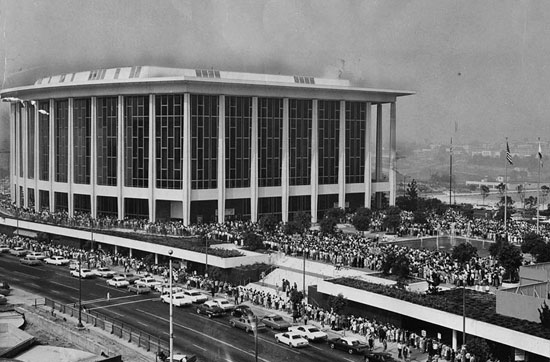
Within a year, the Music Center was a cultural fixture in L.A. Here, thousands of people line up for "Hello, Dolly" tickets. Photo/Herald Examiner
Like any grand dame, she avoids dwelling on birthdays. Still, a half-century is a milestone for a cultural icon in L.A.
So fans of the Los Angeles Music Center have gotten off to an early start in celebrating her upcoming 50-year mark. This week, a launch party on the Dorothy Chandler Pavilion stage kicked off a months-long celebration that will include some 60 large and small programs, including a gala on her December 6 golden anniversary and a public bash the next day on the Music Center Plaza.
“The Music Center has been critical to Los Angeles’ culture,” says Board Chair Lisa Specht. “We’re one of the top three performing arts centers in the country, along with Lincoln and Kennedy Centers, and for decades, we’ve been a hub of creativity.”
Not to mention a game-changer for L.A.’s metropolitan evolution.
“The Music Center was a major turning point in L.A. coming into its own in the postwar era as a major American city,” says Teresa Grimes, a Los Angeles historic preservation consultant who has documented the Center’s architectural heritage for past restoration projects.
Though the Los Angeles Philharmonic had been well established, it had no permanent home at the end of World War II other than the Hollywood Bowl, which was forced to close in 1951 due to a financial crisis, Grimes says. A series of “Save the Bowl” concerts, orchestrated by Dorothy Buffum Chandler, the wife of the Los Angeles Times’ publisher Norman Chandler, reopened the beleaguered band shell, but underscored the cultural shortcomings of the burgeoning city.
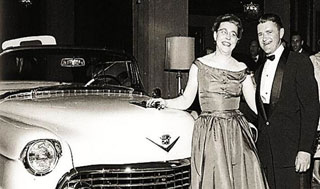
The winners of a Cadillac Eldorado, part of Dorothy Chandler's fundraising drive for Music Center construction.
Between 1951 and 1954, plans for a civic auditorium and convention center had been put on the local ballot three times, but never garnered the two-thirds majority it needed for passage. So in 1955, Chandler and the local Symphony Association began raising private funds for a hall to house the Philharmonic, which for years had been playing in leased space. As the highlight of their gala kickoff at the Ambassador Hotel, they raffled off a new Cadillac El Dorado.
“That was the beginning of it all,” Chandler is quoted as saying in Grimes’ Historic American Buildings Survey. “When we raised $400,000 in a few hours on El Dorado Night, I knew southern Californians wanted a music center badly enough to build it themselves.”
The effort took nearly a decade, at a time during which Downtown L.A. was being radically redeveloped. It required legislative approval and involved civic leaders from Donald Douglas to the Irvine family to Cecil B. De Mille.
Led by their arm-twisting society matron and her family newspaper, the Music Center boosters powered through social barriers dividing the Pasadena elite from Westside show business people, overcame pushback from provincial politicians, outlasted an economic downtown and triumphed in a last-minute squabble over whether the Center would be situated at First and Hope Streets, where the county wanted to put it, or at Chandler’s preferred location, the summit of Bunker Hill.
Chandler won, bumping the planned Department of Water and Power Building to the next block as the once-stately—and by now shabby—community of Bunker Hill was razed beyond recognition. She also brought on the architect of her choice, Welton Becket, who had worked with her on the Hollywood Bowl comeback and had master planned the campus of UCLA.
When Chandler decided during a visit to Europe that a single concert hall wouldn’t suffice, and that the new facility would do better financially if it also had a theater and a smaller forum, she won that battle also. Eventually, her tenacity in the project would put her on the cover of Time magazine.
The ultimate cost of the project was $33.5 million, with some $19 million of it from private contributions, including more than $2 million in small cash donations that local citizens dropped in so-called “Buck Bags” that were designed by Walt Disney and placed at cultural gatherings.
On December 6, 1964, the Dorothy Chandler Pavilion opened, resplendent with its crystal chandeliers and gold-leaf ceiling; the Mark Taper Forum and the Ahmanson Theatre were dedicated two years later. Opening night featured the renowned violinist Jascha Heifetz performing Beethoven’s Violin Concerto in D Major, and the Los Angeles Philharmonic conducted by a 24-year-old Zubin Mehta.
In the ensuing years, everyone who is anyone has performed at the Music Center, from Ingrid Bergman and Nat King Cole to Neil Young and Ravi Shankar. Esa-Pekka Salonen and Simon Rattle made their American debuts at the Music Center, as did groundbreaking productions from “Angels in America” to “Zoot Suit.”
Between 1969 and 1999, most of the Academy Awards ceremonies were held there. The Dorothy Chandler Pavilion is where Sacheen Littlefeather refused Marlon Brando’s Oscar, where a naked man streaked onto national television behind David Niven and where Sally Fields exalted at being really liked by the Academy.
And countless Angelenos have memories of youthful jobs as Music Center ushers.
“I worked there as an usher during my senior year of high school,” recalls William Estrada, now curator and chair of the History Department at the Natural History Museum of Los Angeles County. “It was the days of Zubin Mehta and we were required to wear these heavy, long Nehru-type jackets that were just awful to wear in the summer. Dorothy Chandler had her own parking space, and sometimes one of us was selected to walk her from her car to her seat.”
Today, Estrada notes, the Music Center, built on the site of the old Bunker Hill community, is just one cultural component in a downtown cityscape that is hardly recognizable compared to its pre-1960s, World War II incarnation. And it has expanded: The LA Phil is now housed at Disney Hall, the Center’s latest venue, and the L.A. Opera is at the Dorothy Chandler Pavilion.
Nonetheless, some things change more than others: this week’s anniversary kickoff was sponsored by Cadillac.
Click here to buy tickets to anniversary events and to share your memories of the Music Center, and here to volunteer.
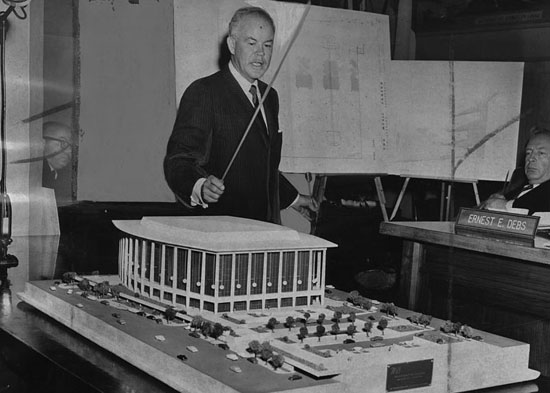
Architect Welton Becket presents plans for the new Music Center to the Board of Supervisors in 1960.
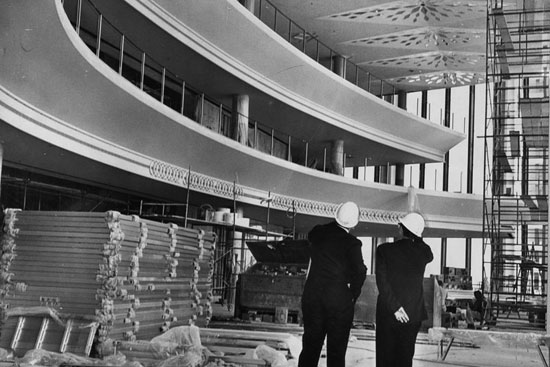
The Music Center was built as a public-nonprofit partnership on county land but was underwritten by private donations. Photo/Herald Examiner
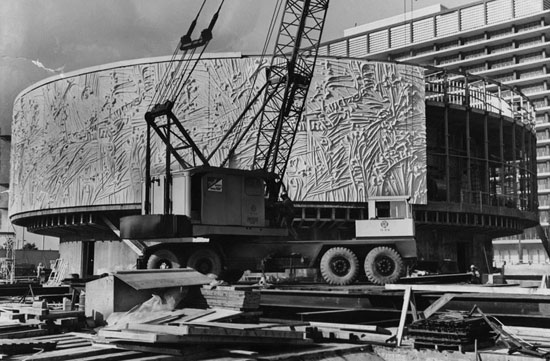
The Mark Taper Forum went up in 1966, covered with a mural of precast terrazzo. Photo/Herald Examiner
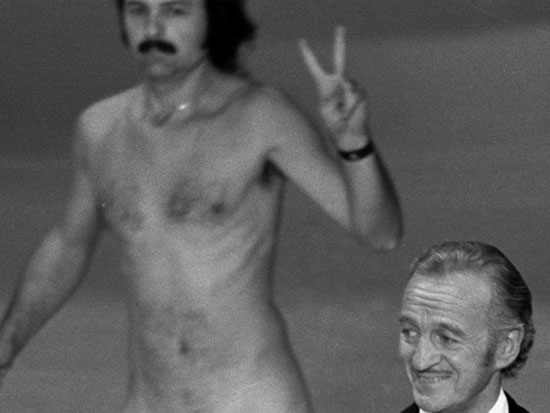
Some memorable moments occurred during the Music Center's reign as the Oscar's home. In 1974, a streaker crashed the party and actor David Niven's presentation.
Posted 4/3/14
Spreading the CicLAvia spirit
April 3, 2014
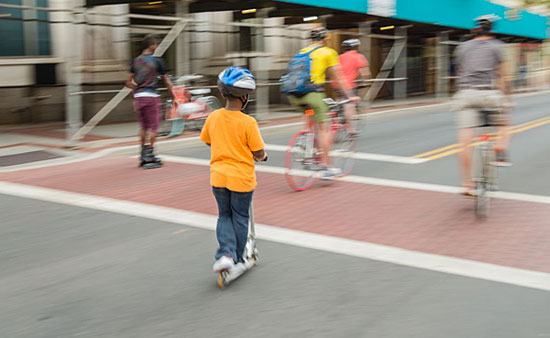
Folks from New Brunswick, New Jersey, above, to Santa Cruz are catching CicLAvia fever. Photo/Frank Villafañe & Rose Rios
Everybody wants to play in the streets these days.
And CicLAvia, a stereotype-busting open streets free-for-all that became an overnight sensation when it rolled into Los Angeles four years ago, has grabbed the handlebars of what’s becoming a nationwide movement, from small towns to big cities.
As 2014’s first CicLAvia prepares to cruise down a car-free Wilshire Boulevard Sunday, L.A. is hosting the first-ever Open Streets National Summit, drawing activists from around the country who want to see how a metropolis allegedly addicted to automobiles is using CicLAvia to reinvent itself.
Summit organizer Michael Samuelson said L.A. was chosen precisely because of the success of CicLAvia, which regularly draws crowds in excess of 100,000.
“L.A.’s got a fantastic thing going,” said Samuelson. “It’s incredibly popular; the streets are packed with people biking and walking every time.”
The Open Streets Project is working in close collaboration with the CicLAvia organization, which will give summit attendees a behind-the-scenes look at one of the most successful open streets initiatives in the nation, said Aaron Paley, executive director and co-founder of CicLAvia. Paley said that the inherent challenges in shutting down major roads in a city like L.A. are a big part of the success story.
“We are the car capital,” Paley said. “There’s this idea that if you can do it in L.A., then the sky’s the limit.”
CicLAvia started in October, 2010, as a once-per-year event inspired by mid-1970s ciclovias in Bogotá, Colombia. (“Ciclovia” translates roughly to “cycleway.”) By 2013, CicLAvia had grown to three events a year. Paley said that he expects L.A. County to get even more open streets events like CicLAvia as funding grows. “There will probably be 10 or 12 events happening around the county each year,” he said.
As CicLAvia gears up to play an even bigger role in L.A., other communities across the country are hopping aboard. As recently as 2007, only eight or nine open streets events were being held across the country, according to Samuelson. Now, they’re taking place in more than 100 cities across North America.
Some of the initiatives, like Sunday Streets in San Francisco and Summer Streets in New York City, have been serving large, bike-savvy populations for years. But the movement is also gaining traction in cities like New Brunswick, New Jersey (pop. 56,000), which held its first ciclovia last October.
“People were asking ‘Why are we doing this?’ They focused on the negative,” said Jaymie Santiago, organizer of the event and director of program operations for New Brunswick Tomorrow. “It exceeded all our expectations. We expected 2,000 people and got 4,500.”
Building on those results, New Brunswick Mayor James Cahill doubled down, partnering with the organization to produce three more ciclovias this year, starting May 4. Santiago is attending this weekend’s summit so he can bring home valuable lessons and perspective.
“Because of the scale of Los Angeles, it sets an example for smaller cities,” Santiago said. “If L.A. can do it, then New Brunswick can do it.”
At the summit, Santiago plans to share some of the early success of his event, which he said is a useful tool in his organization’s fight against poverty in New Brunswick. “One of the symptoms of poverty is isolation,” he said. “By hosting an event like this and reclaiming the streets, it kind of breaks through that.”
Jenn Graham, an organizer for Atlanta Streets Alive in Georgia, hopes the summit will provide her with ideas on how to partner with her city better. “Our event sticks out like a sore thumb because it’s one of the few that’s not organized by the city or in partnership with a city,” she said. While Atlanta Streets Alive has been able to draw some funding from the city of Atlanta, it has relied primarily on cooperation with businesses and nonprofit organizations. Still, Atlanta Streets Alive has grown rapidly, from about 1,500 people in 2010 to 83,000 last October.
Closer to home, Saskia Lucas of Santa Cruz Open Streets said she is “totally excited” to get her first taste of what she called “the largest open streets event in the United States.”
“I’ve watched videos online and it is just so inspiring to see these thousands of Angelenos just taking over major Los Angeles streets with smiles plastered on their faces.”
More of those smiles may be on tap. Last summer, Metro’s Board of Directors invested $2 million in expanding open streets events to all parts of Los Angeles County. A few months later, the board approved a grant program for local groups seeking to produce events.
The Open Streets summit starts on Friday, April 4. About 75 organizers from across the country will gather at the Line Hotel in Koreatown to share ideas, stories and advice on everything from how to grow partnerships with cities to the technical aspects of producing a safe and successful event.
Things culminate with Sunday’s CicLAvia, which will run from downtown to LACMA, in the Miracle Mile district. Locals and visitors alike will be saying so long—for now—to the six-mile long “Iconic Wilshire Boulevard” route, which is going on hiatus as construction of the Purple Line Extension prepares to get underway.
But never fear: This is Los Angeles, where another CicLAvia always seems to be right around the corner. The next one is coming on October 5 in the “Heart of L.A.” Then, on December 7, the route will focus primarily on South L.A. for the first time ever.
Posted 4/3/4
Shaking off complacency
April 3, 2014
Like countless Angelenos, I’ve been a Lucy Jones fan for years.
When it comes to earthquakes, no one conveys information more accessibly—or calms rattled nerves more quickly—than the plain-talking seismic scientist from Caltech. I can still vividly remember the way my family was glued to Jones’ televised briefings in the wake of the deadly Northridge earthquake, which had delivered a powerful jolt to our house and psyches.
In recent days, you’ve probably seen a lot of Jones, more than at any time since that 1994 temblor. She’s been called upon by news organizations here and abroad to put into perspective our recent earthquakes, including last Friday’s magnitude 5.1 near La Habra. As she told The New York Times the other day: “The last 17 years has been the quietest time we’ve seen. Maybe we’re starting to turn back to more normal levels.”
I suspect that for many of you in the post-Northridge generation, this is probably the first time you’ve really felt the earth shake and looked to Jones for answers and reassurance. In fact, Jones became an overnight sensation last weekend after opening her @DrLucyJones Twitter account largely because of followers who were likely still in grade school, or not even born yet, when the Northridge quake hit.
Intrigued by front page headlines like this one in the Los Angeles Daily News—“Scientist charms the Twittersphere”—I scrolled through her Twitter postings to see what insights she was offering her new generation of followers in the space of 144 characters. Of course, she was right on message, as this exchange of tweets showed:
@Joolsthebest: “Are we going to have a bigger earthquake…?
@DrLucyJones: “If I could tell you when the next EQ was going to be, I’d be a lot richer than I am. You need to be ready all the time.”
Jones has rightly seized on our recent spate of earthquakes as a teachable moment in her crusade to shake the public (especially you younger folks) of denial and complacency. The time to prepare, she preaches to all who’ll listen, is now—before we’re walloped by a far more destructive seismic event.
Her suggestions are simple. First, she recommends visiting the website of the Earthquake County Alliance, which offers suggestions on how to prepare, survive and recover from an earthquake. Among the proactive measures she says you can take today: secure moveable items; create a disaster plan and decide how you’ll communicate; organize disaster supplies in convenient locations, and minimize financial hardships by organizing important documents and strengthening property.
From personal experience I’d also highly recommend keeping a pair of slippers by the bed. After the Northridge quake, our young, barefoot daughter was lucky not to cut her feet on the shattered glass strewn throughout the house as she came running into our bedroom.
And, remember, when the quake strikes, “drop, cover and hold on.”
That’s exactly what KTLA news anchors Chris Schauble and Megan Henderson did on the morning of March 17, when a 4.1 quake struck on the Westside. As the studio shook, both ducked under their desk. “Earthquake, we’re having an earthquake,” Schauble exclaimed while taking cover.
In the hours and days that followed, Schauble took a beating. His reaction and facial expressions were ridiculed across the Web; a YouTube clip of the incident has been viewed more than 14 million times. But leave it to Jones to cut through the uncharitable chatter. For her, this was another teachable moment. At a press conference on the quake, she said she was “very proud” of the anchors for protecting themselves. “That is absolutely the right thing to do.”
These days, Jones’ responsibilities have moved well beyond her job at Caltech and the U.S. Geological Survey. Los Angeles Mayor Eric Garcetti recently tapped her for a year-long appointment as a special advisor to draw up an earthquake preparedness plan for the city. And I’ve recruited her as an unpaid consultant for Metro on seismic issues relating to subway tunneling under Beverly Hills.
But thanks to social media, she’s now reaching a vast new audience with her message of individual disaster readiness—and reconnecting with some appreciative fans from earlier times.
“Thank you for always putting my mind at scientific ease after quakes,” one young woman posted on Jones’ Facebook page. “ I have been listening to your advice since I was a child, I even quoted you in science reports!”
Here’s hoping that, like me, you’re following that advice, too.
Posted 4/3/14
3 dead in possible meningitis cluster
April 2, 2014
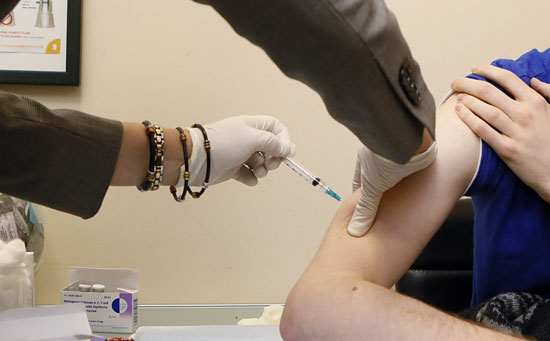
A possible cluster of meningitis cases has health officials urging vaccinations for those at high risk.
Three people have died and five others have fallen ill from meningitis in Los Angeles County since the beginning of 2014, and patterns in the cases have prompted public health officials to urge vaccinations for HIV positive men and those deemed to be at higher risk for contracting the disease.
Public health officials investigating the eight cases said that four of them involve men who had sex with other men. All three of the dead fall into that category; two of them were HIV positive and one was not.
Among the four cases in the possible cluster involving men who had sex with other men, other potential links include the fact that three of the men lived or socialized in West Hollywood or North Hollywood. The ages of the three who died are also similar—27 or 28, while the fourth, who survived, is 50.
A meningitis outbreak in New York last year prompted the health department there to urge men who had regular intimate contact with other men to be vaccinated against the disease. But Los Angeles County public health officials at the time said that was not necessary here, given a lack of connections between the 2013 cases it investigated.
This year, however, common factors among the cases are prompting a different recommendation from the Los Angeles County Department of Public Health, which consulted with the California Department of Public Health and the Centers for Disease Control and Prevention before issuing its alert.
“The facts are different,” said Dr. Jonathan E. Fielding, the county’s director of public health. “We didn’t have the same commonalities then as we do now.”
Although the risk is “very low for the general population,” county officials said that HIV positive men, as well as those who have close or intimate contact with multiple partners, find sex partners online, or share cigarettes and drugs, are at higher risk for the disease and should visit their health care provider to receive the vaccine. Those at high risk who don’t have insurance can get a free vaccination at a county facility.
The Los Angeles cases are all attributed to the strain of meningitis known as invasive meningococcal disease. It is a “sporadic and uncommon bacterial infection of the blood or the lining of the brain and spinal cord that can affect the entire body,” the Department of Public Health said a news release. “The infection can cause brain damage, hearing loss, and even death.”
It is not spread by casual contact, such as being in the same room with someone who is infected, and is less infectious than the flu. The bacteria responsible for the disease are spread by “very close exposure to sneezing and coughing or direct contact with saliva or nose mucus,” the public health statement said.
Meningitis can be treated with antibiotics but because it progresses quickly, “immediate diagnosis and treatment is imperative,” according to the news release. Symptoms include high fever, stiff neck and “altered mental status.”
Under CDC guidelines in place since 2005, all pre-teens and adolescents should receive the meningitis vaccine. A first injection is given at 10 to 12 years old, followed by a booster shot five years later in order to offer protection when the disease is most common, between the ages of 16 and 21. In addition, people who live in close quarters such as dormitories and jails are also considered high risk and advised to get vaccinated as a matter of course.
Still, Fielding said, even those who have been previously vaccinated should get another shot now if they fall into one of the current high risk groups, and if their vaccination was given more than five years ago.
Posted 4/2/14




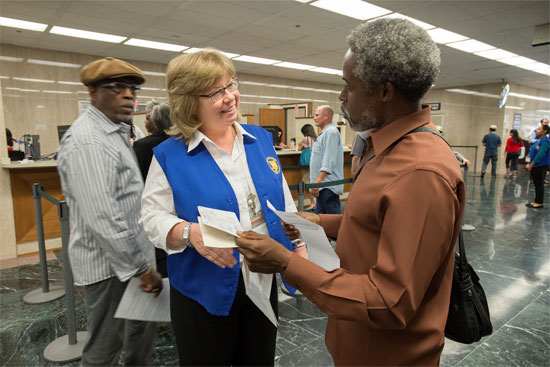
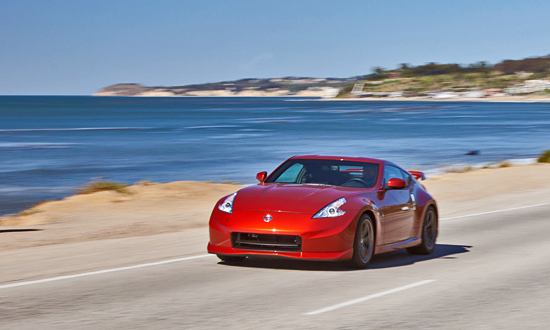
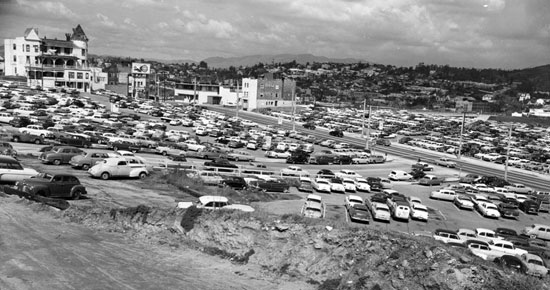
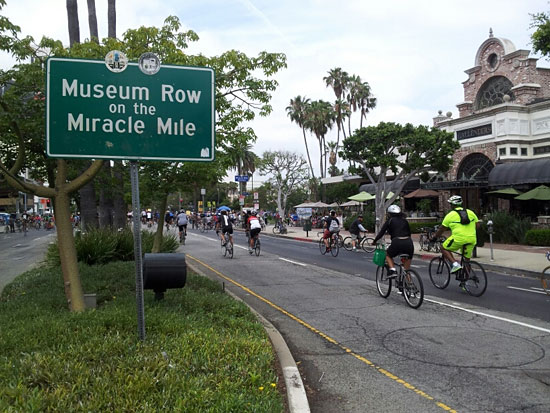






 Check for the latest closure information
Check for the latest closure information








